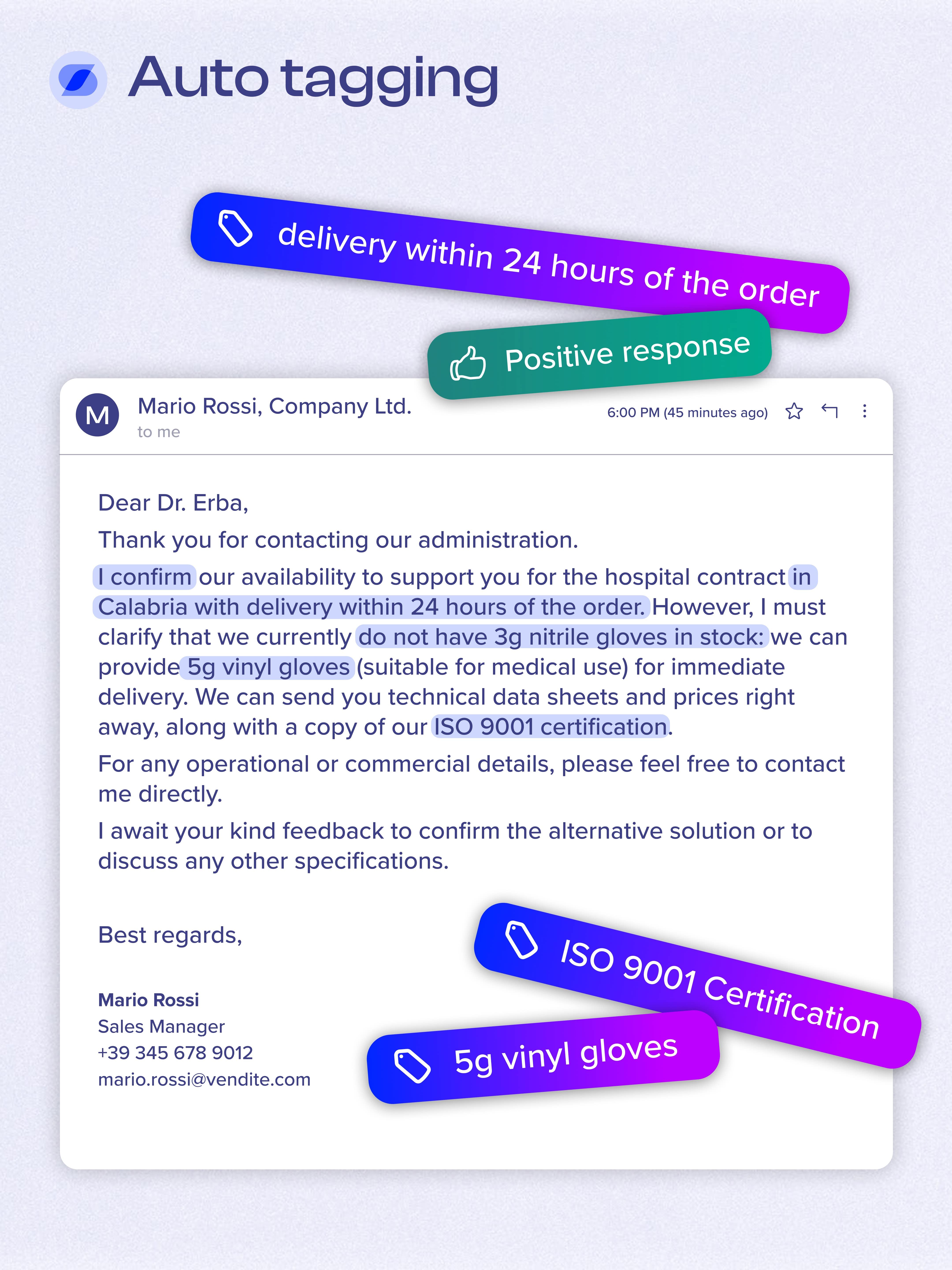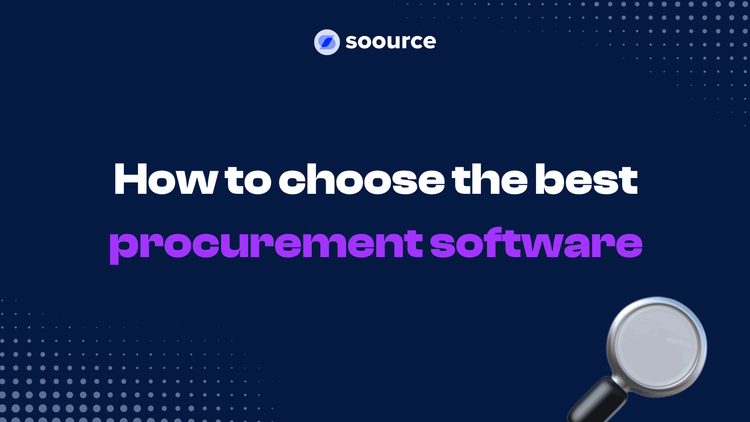How to choose the best procurement software
18/11/2025
•3 MIN READ
In the current economic ecosystem, characterised by global supply chains and increasing cost pressures, the digitisation of purchasing processes is a strategic priority. Procurement software, often integrated with sourcing software modules, enables companies to optimise supplier management, improve transparency, and increase operational efficiency.
Choosing the right platform is not easy: the range of options is wide and requirements vary from organisation to organisation.
This guide outlines the key criteria for identifying the best procurement software based on business objectives and supply chain characteristics.
What is procurement software?
Procurement software is a digital solution that automates the entire purchasing cycle: from request for quotation (RFQ) to supplier selection, contract management and payments.
Unlike traditional ERP systems, procurement software integrates advanced analytics, collaboration and compliance capabilities, supporting decisions based on real data.
Sourcing software, on the other hand, focuses on the strategic phases of the procurement process (searching for, evaluating and negotiating with suppliers), often integrating into the broader digital procurement ecosystem.
This strategic phase is particularly important as the search for and selection of potential suppliers directly affects the success of the entire process. For this reason, many companies decide to adopt a dedicated solution to manage the first part of the cycle: the search for and selection of potential suppliers and the sending of RFXs.
Why invest in procurement software
Companies that adopt a digital procurement system obtain tangible benefits in terms of:
- Operational efficiency: reduction in average order-to-invoice cycle time by up to 60%.
- Transparency and control: centralised monitoring of suppliers, contracts and performance.
- Cost savings: according to Deloitte, procurement automation can reduce indirect costs by up to 30%.
- Sustainability and compliance: supplier traceability and control over ESG criteria.
In a context where supply risk management is increasingly critical, procurement software represents a competitive lever.
Not only that, but the purchasing department is proving increasingly important in companies. Optimising their processes has a positive and direct impact on the entire business.
Investing in procurement software means improving team performance, but also optimising existing data (for example, by cleaning up and organising the database), allowing purchasing departments to negotiate more broadly and based on data.
Key features to consider
When selecting software for the purchasing department, there are several elements to consider, including essential features.
Many modern tools have integrated Artificial Intelligence to speed up and improve the entire workflow, making it a key partner in achieving strategic objectives.
| Objective | AI Application | Benefit |
|---|---|---|
| Reduce operational time | In-depth supplier research from official databases | New suppliers and -60% time spent |
| Reduce manual tasks | Automatic and massive RFX sending | New suppliers and database update |
| Improve negotiation | Data interpretation for benchmarking | Better negotiation |
| Save budget and time | Automated workflows | -70% time spent on manual tasks |
This table can help you understand some use cases for platforms and their technology, so you know what to expect and how to set your software selection criteria
To make the best choice, each team must set objectives and targets, imagining how technology can relieve operational areas of the most repetitive tasks, directing them towards strategies..
Software selection criteria
Here are some of the preparatory processes that guide companies towards adopting digital procurement solutions.
a. Requirements analysis
- Identify critical internal processes and inefficiencies.
- Involve key stakeholders (procurement, IT, finance, legal).
- Define measurable objectives (e.g., 20% reduction in sourcing times).
b. Evaluation of solutions
- Verify the scalability of the software and its ease of integration with existing systems.
- Consider the user experience and the availability of specific modules (sourcing, e-procurement, contracts).
- Request demos and trial periods to test the platform in real scenarios
c. Ecomic analysis and ROI
- Calculate the return on investment considering licence, training and maintenance costs.
- Estimate the savings resulting from automation and the reduction of manual errors.
Through these stages, the purchasing department has the opportunity to evaluate and learn about the procurement software market. Thanks to the demos, it can get to the heart of the matter, testing the solutions in real time.
If you are interested in Soource and would like to book a demo, you can do so now by clicking here.
Integration with sourcing software
An effective sourcing software system enhances the entire procurement cycle, providing tools for:
- Centralise requests for quotations;
- Automate supplier benchmarking;
- Collect performance data and update reliability scores.
Integration with the operational procurement module provides an end-to-end view, from strategic sourcing to contract execution.
Technological evolution: AI and automation in procurement
In recent years, artificial intelligence has redefined sourcing logic, making it possible to simultaneously analyse thousands of offers, predict price fluctuations and identify potential risks in the supply chain.
AI and machine learning-based platforms are transforming the role of the procurement manager from operational executor to strategic decision maker, thanks to predictive insights and the automation of repetitive tasks.
Soource: innovation in digital sourcing
In this scenario, Soource is a concrete example of how AI can improve the efficiency and resilience of procurement.
The platform adopts an innovative sourcing model that leverages artificial intelligence to automate repetitive tasks and compare large networks of suppliers, quickly and accurately identifying the partners best suited to the company's needs.
Soource addresses two complementary challenges:
- It mitigates the risks associated with commodity shortages and price volatility, which are effects of global instability.
- It helps purchasing managers reduce dependence on a limited number of suppliers by expanding the supply base without increasing management time or costs.
Through an extensive and continuously updated proprietary database, Soource allows you to automatically search, contact and qualify thousands of suppliers, collecting information and quotes in a structured manner.
By automatically sending massive, customised RFXs, Soource is able to obtain up-to-date, reliable information, halving waiting times. In fact, 95% of customers receive a positive response within the first 24 hours.

AI also processes data from interactions to progressively improve the quality of the database, generating a powerful network effect.
The result is an intelligent ecosystem capable of supporting more informed, cost-effective and sustainable purchasing decisions: a model that reflects the natural evolution of procurement towards data-driven and predictive processes.
Choosing the best procurement software requires a strategic approach that takes into account not only functionality, but also the platform's ability to evolve alongside the business.
Solutions such as Soource show how the integration of AI, automation and predictive analytics is redefining procurement, transforming it into a more intelligent, flexible and value-oriented process.
FAQ
We have collected the most frequently asked questions here, but don't hesitate to contact us if you have any doubts or want to know more about Soource.
Is Soource compatible with my ERP (Enterprise Resource Planning or Procurement Suite)?
Yes, Soource is compatible with major ERP and procurement software like SAP Ariba, Jaggaer and other enterprise systems. You can integrate it for bidirectional data exchange or use it as a plug & play solution, without the need for integration.
Are my data on Soource protected and secure?
Absolutely. All corporate, personal and supplier data remains your property and is processed according to GDPR and European regulations. Generic data is anonymized to improve platform and Soource community performance.
Where does supplier data on Soource come from?
Soource's database combines:
- Certified and public sources
- Data collected from intelligent web crawling
- Information automatically extracted from corporate emails
Today Soource offers the largest database of Italian companies with direct email contact.
Can I attach files to RFI, RFQ or RFP on Soource?
Yes, you can attach documents in any format to your requests (RFI - Request for Information, RFQ - Request for Quotation or RFP - Request for Proposal). In particular, for RFIs, it is recommended to include a technical specification sheet of the product to get more detailed responses from suppliers.
Can I send follow-ups to suppliers with Soource?
Yes. With Soource you can filter suppliers who haven't responded and send a mass follow-up in one click. This helps you double the response rate, up to 80% on average, improving RFI, RFP and RFQ management.
Is Soource compliant with the European AI Act?
Yes. Soource's artificial intelligence is compliant with the European Union's new AI Act, falling into the zero-risk category, as it only supports internal activities and does not automate outward processes or critical decisions.
Why use Soource for RFI and RFP?
With Soource you can:
- Create RFI (Request for Information) and RFP (Request for Proposal) in just a few clicks
- Send them automatically to selected suppliers
- Analyze responses with artificial intelligence
- Extract and compare certifications, availability, technical capabilities
You save time and identify the best suppliers more quickly.
Can I also use Soource for RFQ?
Yes. Soource also supports RFQ (Request for Quotation) to request economic offers. The platform automates:
- RFQ sending
- Response reception and reading
- Comparison of prices and conditions


